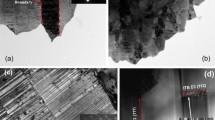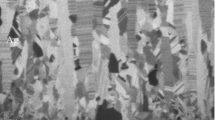Abstract
Sputter-deposited epitaxial (111) and (110) Ag films have high-density nanotwins with respective twin boundary orientations perpendicular and angled to the growth direction. Twin density in as-deposited (111) Ag films is much greater than in (110) films, leading to higher hardness in the (111) films. Annealing up to 800 °C (homologous temperature of 0.85 Tm) leads to increased twin thickness, although the average twin thickness remains < 100 nm in both systems. Twinned volume fraction falls dramatically in annealed (110) films but remains constant at ~50% in (111) films. The mechanisms leading to the elimination of nanotwins in (110) films and their remarkable stability in (111) films at elevated temperatures are discussed. Coarsening and elimination of twins result in hardness reduction after annealing. The variety of microstructures achieved via annealing allows for the introduction of a strengthening model considering both twin and grain boundaries.











Similar content being viewed by others
References
L. Lu, Y.F. Shen, M. Dao, and S. Suresh: Strain rate sensitivity of Cu with nanoscale twins. Scr. Mater. 55 (4), 319 (2006).
S. Suresh, M. Dao, L. Lu, and Y.F. Shen: Strength, strain-rate sensitivity and ductility of copper with nanoscale twins. Acta Mater. 54 (20), 5421 (2006).
S. Suresh, L. Lu, R. Schwaiger, Z.W. Shan, M. Dao, and K. Lu: Nano-sized twins induce high rate sensitivity of flow stress in pure copper. Acta Mater. 53 (7), 2169 (2005).
J.R. Weertman, C.J. Shute, B.D. Myers, S. Xie, T.W. Barbee, and A.M. Hodge: Microstructural stability during cyclic loading of multilayer copper/copper samples with nanoscale twinning. Scr. Mater. 60 (12), 1073 (2009).
J.R. Weertman, C.J. Shute, B.D. Myers, S. Xie, S.Y. Li, T.W. Barbee, and A.M. Hodge: Detwinning, damage and crack initiation during cyclic loading of Cu samples containing aligned nanotwins. Acta Mater. 59 (11), 4569 (2011).
O. Anderoglu, A. Misra, H. Wang, F. Ronning, M.F. Hundley, and X. Zhang: Epitaxial nanotwinned Cu films with high strength and high conductivity. Appl. Phys. Lett. 93 (8), 083108-083108-3 (2008).
L. Lu, X. Chen, X. Huang, and K. Lu: Revealing the maximum strength in nanotwinned copper. Science 323 (5914), 607 (2009).
O. Anderoglu, A. Misra, F. Ronning, H. Wang, and X. Zhang: Significant enhancement of the strength-to-resistivity ratio by nanotwins in epitaxial Cu films. J. Appl. Phys. 106 (2), 024313-024313-9 (2009).
X. Zhang, A. Misra, H. Wang, J.G. Swadener, A.L. Lima, M.F. Hundley, and R.G. Hoagland: Thermal stability of sputter-deposited 330 austenitic stainless-steel thin films with nanoscale growth twins. Appl. Phys. Lett. 87 (23), 233116-233116-3 (2005).
K. Lu, L. Lu, and S. Suresh: Strengthening materials by engineering coherent internal boundaries at the nanoscale. Science 324 (5925), 349 (2009).
L. Lu, Y.F. Shen, X.H. Chen, L.H. Qian, and K. Lu: Ultrahigh strength and high electrical conductivity in copper. Science 304 (5669), 422 (2004).
D. Bufford, X. Zhang, and H. Wang: High strength, epitaxial nanotwinned Ag films. Acta Mater. 59 (1), 93 (2011).
X. Zhang, A. Misra, H. Wang, M. Nastasi, J.D. Embury, T.E. Mitchell, R.G. Hoagland, and J.P. Hirth: Nanoscale-twinning-induced strengthening in austenitic stainless steel thin films. Appl. Phys. Lett. 84 (7), 1096 (2004).
X. Zhang, A. Misra, H. Wang, T.D. Shen, M. Nastasi, T.E. Mitchell, J.P. Hirth, R.G. Hoagland, and J.D. Embury: Enhanced hardening in Cu/330 stainless steel multilayers by nanoscale twinning. Acta Mater. 52 (4), 995 (2004).
P. Gu, M. Dao, R.J. Asaro, and S. Suresh: A unified mechanistic model for size-dependent deformation in nanocrystalline and nanotwinned metals. Acta Mater. 59 (18), 6861 (2011).
C.C. Koch, D.G. Morris, K. Lu, and A. Inoue: Ductility of nanostructured materials. MRS Bull. 24 (2), 54 (1999).
O. Anderoglu, A. Misra, J. Wang, R.G. Hoagland, J.P. Hirth, and X. Zhang: Plastic flow stability of nanotwinned Cu foils. Int. J. Plast. 26 (6), 875 (2010).
N. Li, J. Wang, J.Y. Huang, A. Misra, and X. Zhang: Influence of slip transmission on the migration of incoherent twin boundaries in epitaxial nanotwinned Cu. Scr. Mater. 64 (2), 149 (2011).
N. Li, J. Wang, A. Misra, X. Zhang, J.Y. Huang, and J.P. Hirth: Twinning dislocation multiplication at a coherent twin boundary. Acta Mater. 59 (15), 5989 (2011).
T. Chookajorn, H.A. Murdoch, and C.A. Schuh: Design of stable nanocrystalline alloys. Science 337 (6097), 951 (2012).
L.E. Murr: Interfacial Phenomena in Metals and Alloys (Addison-Wesley Pub. Co., Adv. Book Program, London, 1975).
J.P. Hirth and J. Lothe: Theory of Dislocations (Wiley, New York, 1982).
O. Anderoglu, A. Misra, H. Wang, and X. Zhang: Thermal stability of sputtered Cu films with nanoscale growth twins. J. Appl. Phys. 103 (9), 094322-094322-6 (2008).
X. Zhang and A. Misra: Superior thermal stability of coherent twin boundaries in nanotwinned metals. Scr. Mater. 66 (11), 860 (2012).
J. Wang, O. Anderoglu, J.P. Hirth, A. Misra, and X. Zhang: Dislocation structures of Sigma 3 112 twin boundaries in face centered cubic metals. Appl. Phys. Lett. 95 (2), 021908-021908-3 (2009).
D.L. Medlin, G.H. Campbell, and C.B. Carter: Stacking defects in the 9R phase at an incoherent twin boundary in copper. Acta Mater. 46 (14), 5135 (1998).
J. Wang, N. Li, O. Anderoglu, X. Zhang, A. Misra, J.Y. Huang, and J.P. Hirth: Detwinning mechanisms for growth twins in face-centered cubic metals. Acta Mater. 58 (6), 2262 (2010).
L. Liu, J. Wang, S.K. Gong, and S.X. Mao: High resolution transmission electron microscope observation of zero-strain deformation twinning mechanisms in Ag. Phys. Rev. Lett. 106 (17), 175504 (2011).
N. Li, J. Wang, X. Zhang, and A. Misra: In-situ TEM study of dislocation-twin boundaries interaction in nanotwinned Cu films. JOM 63 (9), 62 (2011).
L. Xu, D. Xu, K.N. Tu, Y. Cai, N. Wang, P. Dixit, J.H.L. Pang, and J.M. Miao: Structure and migration of (112) step on (111) twin boundaries in nanocrystalline copper. J. Appl. Phys. 104 (11), 113717-113717-5 (2008).
C.B. Carter, D.L. Medlin, J.E. Angelo, and M.J. Mills: The 112 lateral twin boundary in FCC materials. Mater. Sci. Forum207–212 (1996).
T.C. Nason, G.R. Yang, K.H. Park, and T.M. Lu: Study of silver diffusion into Si(111) and Sio2 at moderate temperatures. J. Appl. Phys. 70 (3), 1392 (1991).
L. Weber: Equilibrium solid solubility of silicon in silver. Metall. Mater. Trans. A. 33 (4), 1145 (2002).
P.Y. Chevalier: Thermodynamic evaluation of the Ag-Si system. Thermochim. Acta 130, 33 (1988).
S.J. Rothman, N.L. Peterson, and J.T. Robinson: Isotope effect for self-diffusion in single crystals of silver. Phys. Status Solidi. 39 (2), 635 (1970).
J. Bihr, H. Mehrer, and K. Maier: Comparison between microsectioning studies of low-temperature self-diffusion in silver. Phys. Status Solidi A. 50 (1), 171 (1978).
P. Varotsos and K. Alexopoulos: Calculation of diffusion-coefficients at any temperature and pressure from a single measurement. 1. Self-diffusion. Phys. Rev. B. 22 (6), 3130 (1980).
D. Hull and D.J. Bacon: Introduction to Dislocations, 4th ed. (Butterworth Heinemann, Boston, 2001).
L.M. Clarebro, R.L. Segall, and M.H. Loretto: Faulted defects in quenched copper and silver. Philos. Mag. 13 (126), 1285 (1966).
G.M. Pharr and W.C. Oliver: Nanoindentation of silver-relations between hardness and dislocation-structure. J. Mater. Res. 4 (1), 94 (1989).
D. Christopher, R. Smith, and A. Richter: Atomistic modelling of nanoindentation in iron and silver. Nanotechnology 12 (3), 372 (2001).
D.C. Jang, X.Y. Li, H.J. Gao, and J.R. Greer: Deformation mechanisms in nanotwinned metal nanopillars. Nat. Nanotechnol. 7 (9), 594 (2012).
B.N. Singh, A.J.E. Foreman, and H. Trinkaus: Radiation hardening revisited: Role of intracascade clustering. J. Nucl. Mater. 249 (2-3), 103 (1997).
D.B. Williams and C.B. Carter: Transmission Electron Microscopy: A Textbook for Materials Science (Plenum, New York, 1996), pp. 321–322.
G.I. Taylor: The mechanism of plastic deformation of crystals. Part I. Theoretical. Proc. R. Soc. London, Ser. A. 145 (855), 362 (1934).
M.L. Grossbeck, P.J. Maziasz, and A.F. Rowcliffe: Modeling of strengthening mechanisms in irradiated fusion-reactor 1st wall alloys. J. Nucl. Mater. 191, 808 (1992).
M. Mata, M. Anglada, and J. Alcala: Contact deformation regimes around sharp indentations and the concept of the characteristic strain. J. Mater. Res. 17 (5), 964 (2002).
D. Tabor: The Hardness of Metals (Oxford University Press, Oxford, UK, 2000), pp. 105.
M.H. Zhao, W.S. Slaughter, M. Li, and S.X. Mao: Material-length-scale-controlled nanoindentation size effects due to strain-gradient plasticity. Acta Mater. 51 (15), 4461 (2003).
A.V. Panin, A.R. Shugurov, and K.V. Oskomov: Mechanical properties of thin Ag films on a silicon substrate studied using the nanoindentation technique. Phys. Solid State 47 (11), 2055 (2005).
Y.F. Cao, S. Allameh, D. Nankivil, S. Sethiaraj, T. Otiti, and W. Soboyejo: Nanoindentation measurements of the mechanical properties of polycrystalline Au and Ag thin films on silicon substrates: Effects of grain size and film thickness. Mater. Sci. Eng., A 427 (1-2), 232 (2006).
Y.Q. Fu, C. Shearwood, B. Xu, L.G. Yu, and K.A. Khor: Characterization of spark plasma sintered Ag nanopowders. Nanotechnology. 21 (11), 115707 (2010).
R.J. Asaro and S. Suresh: Mechanistic models for the activation volume and rate sensitivity in metals with nanocrystalline grains and nano-scale twins. Acta Mater. 53 (12), 3369 (2005).
P. Gu, B.K. Kad, and M. Dao: A modified model for deformation via partial dislocations and stacking faults at the nanoscale. Scr. Mater. 62 (6), 361 (2010).
J.L. McCall: Practical applications of quantitative metallography: A symposium (American Society for Testing and Materials, Ann Arbor, MI, 1984).
M.D. Merz and S.D. Dahlgren: Tensile-strength and work-hardening of ultrafine-grained high-purity copper. J. Appl. Phys. 46 (8), 3235 (1975).
A. Misra, J.P. Hirth, and R.G. Hoagland: Length-scale-dependent deformation mechanisms in incoherent metallic multilayered composites. Acta Mater. 53 (18), 4817 (2005).
X. Zhang, A. Misra, H. Wang, A.L. Lima, M.F. Hundley, and R.G. Hoagland: Effects of deposition parameters on residual stresses, hardness and electrical resistivity of nanoscale twinned 330 stainless steel thin films. J. Appl. Phys. 97 (094302), 5 (2005).
B. Zhu, R.J. Asaro, P. Krysl, and R. Bailey: Transition of deformation mechanisms and its connection to grain size distribution in nanocrystalline metals. Acta Mater. 53 (18), 4825 (2005).
Acknowledgments
We acknowledge financial support by NSF-DMR metallic materials and nanostructures program under grant no 0644835. Access to the microscopes at the Microscopy and Imaging Center at Texas A&M University is also acknowledged.
Author information
Authors and Affiliations
Corresponding author
Additional information
This author was an editor of this focus issue during the review and decision stage. For the JMR policy on review and publication of manuscripts authored by editors, please refer to http://www.mrs.org/jmr-editor-manuscripts/.
Rights and permissions
About this article
Cite this article
Bufford, D., Wang, H. & Zhang, X. Thermal stability of twins and strengthening mechanisms in differently oriented epitaxial nanotwinned Ag films. Journal of Materials Research 28, 1729–1739 (2013). https://doi.org/10.1557/jmr.2013.50
Received:
Accepted:
Published:
Issue Date:
DOI: https://doi.org/10.1557/jmr.2013.50




